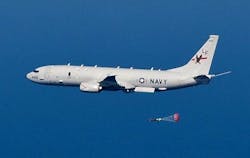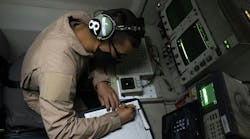Officials of the Naval Air Systems Command at Patuxent River Naval Air Station, Md., announced a $60.8 million contract modification Friday to the Boeing Co. Defense, Space & Security segment in Seattle for several enhancements to the P-8A aircraft command, control, communications, computers, intelligence, surveillance, and reconnaissance (C4ISR) capabilities.
The modification is to mature C4ISR technologies aboard the Poseidon Increment 3 Block 2 aircraft. The order involves Minotaur; Multi-Static Active Coherent (MAC) enhancements; wide-band satellite communications (SATCOM); a new computing and security architecture; automated digital network system common data link upgrades; anti-surface warfare signals intelligence (SIGINT); combat system architecture improvements; and communication capability upgrades.
Minotaur most likely involves an integrated sensors, signal processing, and communications system to enable P-8A aircrews to gather and process surveillance information for transmission to other shore and surface operators.
Related: Boeing moves forward with flying torpedo high-altitude ASW attack system for P-8A aircraft
The U.S. Coast Guard reportedly has been installing a system called Minotaur from the L-3 Communications Platform Integration segment in Waco, Texas, aboard Coast Guard C-130J long range surveillance aircraft.
The Coast Guard's Minotaur project is developing a new standardized mission system with next-generation mission control processor to incorporate the HC-130 aircraft's radar, sensors, and other C4ISR equipment.
At nearly the same time, the U.S. Air Force Research Laboratory's Information Directorate in Rome, N.Y., is working with industry on the Multi-INt Operations Technologies And Unification Research (MINOTAUR) project.
This research initiative seeks to incrementally deliver a suite of tools and technologies to enhance open-architecture intelligence information systems from the sensor through the analyst, chain of command, and out to the operational units.
Related: BAE Systems to develop MAD ASW drone to help Navy P-8A find submarines from high altitudes
The Air Force MINOTAUR project seeks to integrate several intelligence sources and improve the fusion, processing, and exploitation of raw source data from the battlefield to actionable mission criteria through assured and adaptable technologies.
These tools and technologies will be able to share information securely and integrate new sensors and sources of data to modernize intelligence-gathering systems; integrate new sensors and data sources into existing systems; develop new tools for processing raw intelligence data; and speed access to intelligence.
The Multi-Static Active Coherent (MAC) project is an anti-submarine warfare (ASW) system that seeks to detect, locate, and identify enemy submarines using sonar emitters and receivers in separate locations on separate platforms, such as submarines, surface ships, ASW sonobuoys, and helicopter dipping sonar.
MAC brings coherent acoustic source technology and improved signal processing to the P-8A, P-3C Anti-Surface Warfare Improvement Program (AIP), and other Navy ASW aircraft.
Related: Navy spending $1.5 billion to buy another 13 P-8A Poseidon maritime patrol aircraft
This order also involves wide-band satellite communications (SATCOM); a new computing and security architecture; automated digital network system common data link upgrades; anti-surface warfare signals intelligence (SIGINT); combat system architecture improvements; and communication capability upgrades.
On this contract modification Boeing will do the work in Puget Sound, Wash; Patuxent River Naval Air Station, Md.; Huntington Beach, Calif; Dallas; and St. Louis, and should be finished by February 2019.
For more information contact Boeing Defense, Space & Security online at www.boeing.com/defense, or Naval Air Systems Command at www.navair.navy.mil.
Learn more: search the Aerospace & Defense Buyer's Guide for companies, new products, press releases, and videos



